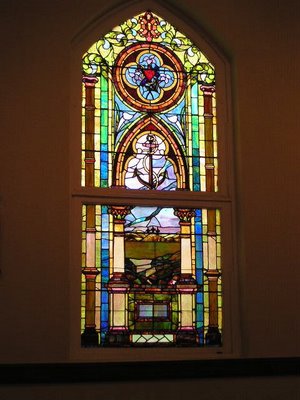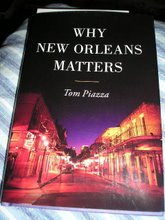The first was "St Dominic Catholic Church" on Harrison Avenue, just off Canal Street in Lakeview. It is a stunning structure built in 1961 and designed by the New Orleans architect Irving Kohler.


Greeting you at the entrance to the church is St Dominic himself displaying the battle scars of the Katrina waterlines for all to witness. Each church has its history of surviving against the odds of fires, demographic changes and, of course hurricanes.

When I entered the church I was in awe of the size and scale of the place. It is very modern but also very stately. I should like to quote the art notes they gave us for the tour:
"The windows at St Dominic church, especially those in the nave, are striking. They were designed and created by the Botz und Miesen Studio of Cologne, Germany. the company sent one of its artists to New Orleans to capture local elements, such as Spanish moss, in the designs. The symbol at the center of each cartouche reflects some aspect of the Dominican belief and practice, such as the black-and-white Dominican shield, the trumpet of St. Vincent Ferrer, and the crown of thorns of St. Catherine of Siena."


I know the grey structural elements are inspired by the louisiana swamp plants but I find them more mechanical, industrial or reminiscient of the architectural details of New Orleans.
The transcept windows, east and west of the altar are huge striking abstracts. The east is symbolic of Mary and the west of Christ's passion. I was particularly taken with the huge droplets of blood that are represented in almost 3-D. They were designed by the German artist, Fanz Pauli.


The window that struck me on first entering the church was the one on the south wall. It is huge and magnificent. It is designed by
John Chase, an important artist and historian from New Orleans. The normal procedure for designing figures in stained glass windows on this scale is to make the head much larger than the feet so that the figure is in proportion to those looking up at it. This convention was not followed by Chase and consequentially Christ has great big clod hoppers of feet. The very nice lady that took our tour for this church told us that many people see this as making Christ appear more human and symbolise his "walking" the earth.

There are also lots of ceramic figures of saints around the church walls. They are very unusual and sometimes seem like they are almost appearing out of the walls themselves. We were told of one in particular -
St Peter Martyr. He refused to die.
















































